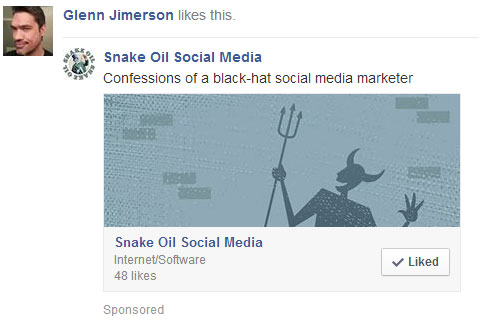Facebook Advertising Fraud Experiment

Facebook advertising fraud is a concern for every online marketer. This is one of the worst kept secrets of the online ad world. It’s not just Facebook. Google Adwords is rife with it as well. A few weeks ago Veritasium published an eye opening video exposing these fake clicks by using a honeypot.
Being an Internet marketer that created multiple Facebook advertising campaigns, I was surprised by their findings. The first criticism I had was that Veritasium didn’t target very well which lead to garbage clicks. They did exclude common click farm countries but if they went farther could it be weeded out entirely?
I then ran an experiment to see if I could recreate their findings and hopefully figure out a way to use better targeting to minimize/eliminate fraud. Besides, I’m an experienced Internet marketer, I can outwit a bunch of YouTube stars and click farm workers. Well, come to find out, no I couldn’t.
Facebook Advertising Fraud Experiment: Snake Oil Social
On February 27th I created a simple Facebook ad campaign in order to increase the number of Likers on my page Snake Oil Social . The idea is that I would keep the targeting laser focused to the Phoenix area who expressed interest in Internet Marketing and Reputation Management. Theoretically, the number of fake profiles should be small to non-existent as the niche isn’t as popular as Veritasium’s Virtual Cat and the geographic targeting was limited to Phoenix, AZ.
Campaign Setup
The campaign consisted of two ads:
The first ad should give me targeted niche Likers in the Phoenix area. Running under the assumption that those people would be real and have real friends, the second Sponsored Story ad would appear to the friends of these authentic users. Brilliant right?
Facebook Ad Campaign Results
In 7 days the campaign generated :
- 26 new Likers
- 1 Website click
- 1 post share
One of those new Likers unliked the page the next day so the net was 25. Despite the crippling feeling of abandonment over the loss of the random liker, I pressed on.
Not Smart Enough: Fake Likers Detected
Since my page following is so small, I can easily keep tabs on these newly acquired Likers. They can be broken to three broad groups:
- Authentic Likers: 17
- Suspicious: 6
- Fake: 3
The authentic likers were just that. I determined authenticity by looking at the info they share publically. A real Liker will have comments and Likes from other real profiles. A little Google kung fu produced their other social profiles. Also, a Google image search of their profile photos wouldn’t pull up any conflicting information.
The second group I classified as suspicious. The reason for this is two fold:
- They passed the majority of the authentic profile tests, but lacked any connection with Social or Internet marketing in general
- On average they liked 1000 pages or more.
This group is an odd bunch. While they didn’t look outright fake, there is just something off about them. At best they aren’t going to be interested in my page and any update will get lost in the shuffle of the other thousand+ page updates they would get on any given day. I’m not including them in my Liker yield because either way I’m not going to get much from them. If anything, they are going to hurt my organic reach.
The Fake profiles are blatant. Let me introduce you to Kelsey Rodriguez from Buckeye Arizona.
Dos Equis needs to feature her as the Most Interesting Woman since she has 1, 987 followers. Are there even 1,987 people in Buckeye?
Kelsey likes a lot of things:
Yes you read that correctly, she likes 37,244 Facebook pages. Then I see a picture she shared that isn’t completely in English.
According to Google Translate, it’s Filippino. What did I tell you; interesting indeed. I doubt she learned that at Verrado High. So, either Kelsey is a multilingual voracious consumer of Facebook pages, music, and, sports or she’s a click farm employee from the Philippines.
Before and After Facebook Ads
Snake Oil Social had 23 Likers the day this experiment started. They were 100% authentic because I went on a Like begging campaign and guilted my friends into Liking the page. After a week of running Facebook ads, I have 48 total Likers of which only 81% are authentic.
| Total Likers | Real Likers | Fake Likers | % Real Likers | |
| Before | 23 | 23 | 0 | 100% |
| After | 48 | 39 | 9 | 81% |
| Delta | +25 | +16 | +9 | -20% |
Facebook Ads Experiment Take Aways
Despite focused targeting on a niche topic, the fake Likers found me. Hat tip to Veritasium. You guys are pretty damn good for a bunch of YouTube stars. Jealous rage rising… So what does this mean:
- Facebook ads can generate new authentic Likers
- Fake Likers are a real problem and greater targeting will not weed them out
- These fake and suspicious Likers will negatively impact your organic reach on Facebook
Keep in mind that this was a very small test and numbers can vary wildly at this size. Maybe I was unlucky with 36% of the new Likers acquired being garbage. Your mileage may vary.
If you run a Facebook ads campaign you have to account for this spoilage. Facebook reports the cost per Like at $1.29. When I compensate for the 9 useless Likers the cost per “real” Like goes up to $1.97. This represents a 52.71% increase in cost per acquisition.
So, is it worth advertising on Facebook? I’d still say yes but you need to understand that you won’t yield 100% authentic Likers. And as it stands, your organic reach will decrease with every fake Liker added. In the long run, the more Likers you generate via ads the more locked in you will be to paying for advertising in order to get your posts seen. Granted, Facebook keeps making changes to lessen organic reach. Brands are going to have to accept that Facebook advertising is looking more like pay to play instead of a best content gets exposure meritocracy. You know, the stuff that made social media marketing worthwhile in the first place. But that’s a topic for another day.
Folks, if you have any questions, comments, or if you’ve run similar test like this, please leave a comment below.












